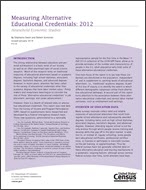
An official website of the United States government
Here’s how you know
Official websites use .gov
A .gov website belongs to an official government organization in the United States.
Secure .gov websites use HTTPS
A lock (
) or https:// means you’ve safely connected to the .gov website. Share sensitive information only on official, secure websites.
-
//
- Census.gov /
- Publications /
- Measuring Alternative Educational Credentials: 2012
Measuring Alternative Educational Credentials: 2012
Measuring Alternative Educational Credentials: 2012
Introduction
The strong relationship between education and personal achievement is a basic tenet of our society, as well as an often-examined topic of social science research.1 Much of this research relies on traditional measures of educational attainment based on academic degrees, including high school diplomas, associate’s degrees, bachelor’s degrees, and advanced degrees. However, in recent years, attention has been called to the variety of educational credentials other than academic degrees that have labor market value.2 Policy makers and researchers have begun to consider the role of these “alternative educational credentials” in job placement, earnings, and career advancement.3
However, there is a dearth of relevant data on alternative educational credentials. This report uses new data from the Survey of Income and Program Participation (SIPP), based on questionnaire items researched and developed by a federal interagency research team. These new questions, administered to a nationally representative sample for the first time in the Wave 13 (fall 2012) collection of the 2008 SIPP Panel, allow us to provide estimates of the number and characteristics of people in the U.S. adult population who hold some of these alternative educational credentials.
One main focus of the report is to see how these credentials are distributed in the population, independent of, and in supplement to, existing levels of educational attainment, i.e., “traditional” academic degrees. A part of this line of inquiry is to identify the extent to which different demographic subgroups utilize these alternative educational pathways. A second part of this report turns attention to the association between these alternative educational credentials and various labor market outcomes, such as employment and earnings.
_______________
1 See, for example, Michael Hout, “Social and Economic Returns to College Education in the United States,” Annual Review of Sociology, 38:379–400, 2012.
2 See, for example, Anthony Carnevale, Stephen Rose, and Andrew Hanson, Certificates: Gateway to Gainful Employment and College Degrees, Georgetown Center on Education and the Workforce, 2012.
Morris Kleiner and Alan Krueger, “The Prevalence and Effects of Occupational Licensing,” British Journal of Industrial Relations, 48:676–687, 2010.
3 President Obama recognized their value in his 2009 State of the Union address when he asked “every American to commit to at least one year or more of higher education or career training…[including] community college or a 4-year school; vocational training or an apprenticeship.” The President’s challenge is rooted in a desire to have a more skilled workforce and population.
President Barack Obama, Address to Joint Session of Congress, February 24, 2009, accessed online on 4/4/2013 at <www.whitehouse.gov/the_press_office/Remarks-of-President-Barack-Obama-Address-to-Joint-Session-of-Congress>.
Others in Series
Publication
Publication
Publication
Share
Some content on this site is available in several different electronic formats. Some of the files may require a plug-in or additional software to view.
 Yes
Yes
 No
NoComments or suggestions?


Top

